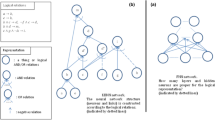Abstract
To implement schemas and logics in connectionist models, some form of basic-level organization is needed. This paper proposes such an organization, which is termed a discrete neural assembly. Each discrete neural assembly is in turn made up of discrete neurons (nodes), that is, a node that processes inputs based on a discrete mapping instead of a continuous function. A group of discrete neurons (nodes) closely interconnected form an assembly and carry out a basic functionality. Some substructures and superstructures of such assemblies are developed to enable complex symbolic schemas to be represented and processed in connectionist networks. The paper shows that logical inference can be performed precisely, when necessary, in these networks and with certain genaralization, more flexible inference (fuzzy inference) can also be performed. The development of various connectionist constructs demonstrates the possibility of implementing symbolic schemas, in their full complexity, in connectionist networks.
Similar content being viewed by others
References
M. Arbib,From schema theory to language, Oxford U. Press, New York, NY, 1987.
L. Fang and W. Wilson, “A study of Sequence Processing on Neural Networks,”Proc. IJCNN, Washington DC, pp. 588–598, IEEE Press, 1989.
J. Feldman and D. Ballard, “Connectionist models and their properties,“,Cognitive Science, 205–254, 1982.
J. Fodor and Z. Pylyshyn, “Connectionism and Cognitive Architecture: A Critical Analysis,”Connections and Symbols. Cambridge, MA: MIT Press, 1988.
B. Inhelder and J. Piaget,The Growth of Logical Thinking from Childhood to Adolescence, Routledge and Kegan Paul, London, England, 1958.
T. Lange and M. Dyer, “Frame selection in a connectionist model,”Proc. 11th Cognitive Science Conference, pp. 706–713. Hillsdale, NJ: Lawrence Erlba um Associates, 1989a.
T. Lange and M. Dyer, “High Level Inferencing in a Connectionist Net work,”Connection Science, pp. 181–217, 1989b.
R. Miikkulainen and M. Dyer, “Natural language processing with modular PDP networks and distributed lexicons,”Cognitive Science, 15(3), pp. 343–399, 1991.
M. Minsky, “A Framework for Representing Knowledge,” in, J. Hughland (ed.)Mind Design, MIT Press, Cambridge, MA, 1983.
S. Pinker and A. Prince, “On Language and Connectionism,”Connections and Symbols, Cambridge, MA: MIT Press, 1988.
D. Rumelhart, J. McClelland, and PDP Research Group,Parallel Distributed Processing: Explorations in the Microstructures of Cognition, Cambridge, MA: MIT Press, 1986.
R. Schank,Scripts, Plans and Goals, LEA, Hillsdale, NJ, 1977.
L. Shastri and V. Ajjanagadde, “From simple association to systematic reasoning,” Tech. Report MS-CIS-90-05, University of Pennsylvania, 1990.
R. Sun, “A discrete neural network model for conceptual representation and reasoning,”Proc. 11th Cognitive Science Society Conference, pp. 916–923. Hillsdale, NJ: Lawrence Erlbaum Associates, 1989.
R. Sun, “The Discrete Neuronal Models and the Probabilistic Discrete Neuronal Models,” in B. Soucek ed.Neural and Intelligent System Integration, pp. 161–178. New York, NY: John Wiley and Sons, 1991.
R. Sun, “Connectionist Models of Commonsense Reasoning Incorporating Rules and Similarities,”Knowledge Acquisition, vol. 4, pp. 293–321, 1992a.
R. Sun, “On variables binding in connectionist networks’,Connection Science, vol. 4, no. 2, pp. 93–94, 1992b.
R. Sun, “A Neural Network Model of Causality,”IEEE Transaction on Neural Networks, vol. 5, no. 4, pp. 604–611, 1994.
R. Sun,Integrating Rules and Connectionism for Robust Commonsense Reasoning, John Wiley and Sons, New York, NY. 1994.
R. Sun and L. Bookman, “How do symbols and networks fit together?”Artificial Intelligence magazine, pp. 20–23, Summer, 1993.
R. Sun and D. Waltz, “Neurally Inspired Massively Parallel Model of Rule-Based Reasoning.” in B. Soucek ed.Neural and Intelligent System Integration, pp. 341–381, New York, NY: John Wiley and Sons, 1991
L. Zadeh, “Fuzzy Logic,”Computer, vol. 21, no. 4, pp. 83–93, 1988.
C. Chang and R. C. Lee,Symbolic Logic and Mechanical Theorem Proving, Academic Press, Reading, MA, 1973.
P. Smolensky, “On the proper treatment of connectionism”,Behavioral and Brain Sciences, 11, pp. 1–43, 1988.
M. R. Quillian, “Semantic memory,” in M. Minsky, (ed.)Semantic Information Processing. MIT Press, 1968.
Author information
Authors and Affiliations
Rights and permissions
About this article
Cite this article
Sun, R. Schemas, logics, and neural assemblies. Appl Intell 5, 83–102 (1995). https://doi.org/10.1007/BF00877227
Issue Date:
DOI: https://doi.org/10.1007/BF00877227




